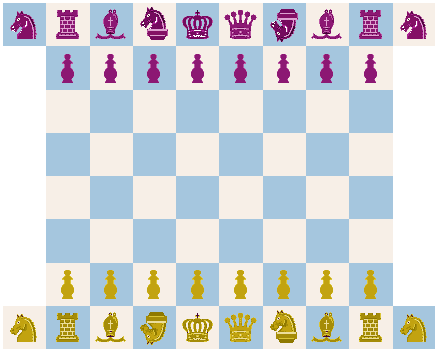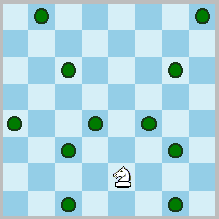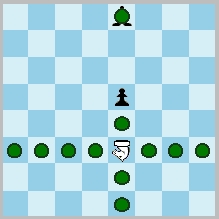

In Gustavian Cannonrider Chess "Cannonriders" are initially positioned on the Bishop files (and Knights are placed on the four extra corner squares of the Gustavian board). The Cannonrider moves differently depending on the colour of the square. On black squares it moves like a Cannon: it slides like a Rook, but can capture an enemy only if there is another piece (of either side) in between, and any interim squares are empty. Thus to capture it leaps over the intervening piece and lands on the enemy piece, like a cannonball. If positioned on a white square it jumps like a Nightrider, that is, can make continuous knight jumps in the same direction, provided that the interim squares are empty. Note that the Kings are initially positioned on the d-file. Otherwise, the rules are the same as in standard chess, except for the possible pawn promotion to Cannonrider.
The Cannonrider's value is 5, that is, the same as a Rook. The Cannonrider's image also changes when it moves to a square with a different colour (it rotates). This makes it easier to understand the piece.The Cannonrider is a very interesting piece for the tactician. Positionally, too, it could be quite dangerous because one can sometimes sacrifice a Cannonrider for a light piece (Knight or Bishop) to achieve positional ends. In the middlegame the Cannonrider is more valuable than a Rook, due to its dangerous tactical capabilities. But in the endgame it is less valuable than a Rook. An obvious case is the endgame King + Cannonrider vs. King, while it cannot give mate to the enemy King. Watch out for fool's mates in the opening. If the Cannonrider is placed on a black square on the king's file, then it could mean mate. There is no way for white to secure an advantage by an immediate activation of a Cannonrider.

The Cannonrider, standing on a white square, can jump like a knight, but also has the continuous knight jumps.

The Cannonrider, standing on a black square, can slide like a rook. But it can only capture by jumping over any intervening piece and landing on an enemy piece.
There is also a variant where Scorpions take the place of the pawns (see Scorpion Chess). The Scorpion has the additional moves of a Knight, but only in two forward directions: east-north-east, and west-north-west. There are no additional capture moves.The Scorpion's value is half the value of a Knight or Bishop, that is, 1.5. This means that a light piece can be exchanged for two Scorpions, a possibility which often occurs. In the endgame it could become very dangerous, and its value often increases.)
The Cannon movement derives from the Cannon in Chinese Chess (Xiangqi). The Nightrider movement was invented by the British chess problem composer T.R. Dawson. The board type was conceived by Gustav III of Sweden (1746-92) for his own chess variant Gustav III's Chess. The Gustavian board makes it possible to place additional pieces on the board without substantially increasing the board size. This often means that a strategical and tactical intensity is maintained. Gustavian Cannonrider Chess, and the Cannonrider piece, were invented by undersigned, July 2006. The Scorpion pawn derives from my Scorpion Chess. See also Cannonrider Chess.
• You can download my free Gustavian Cannonrider Chess program here, (updated 2006-12-11) but you must own the software Zillions of Games to be able to run it.
• Try playing Gustavian Cannonrider Chess by e-mail, against a human opponent, here.
• Don't miss my other chess variants.
© M. Winther 2006